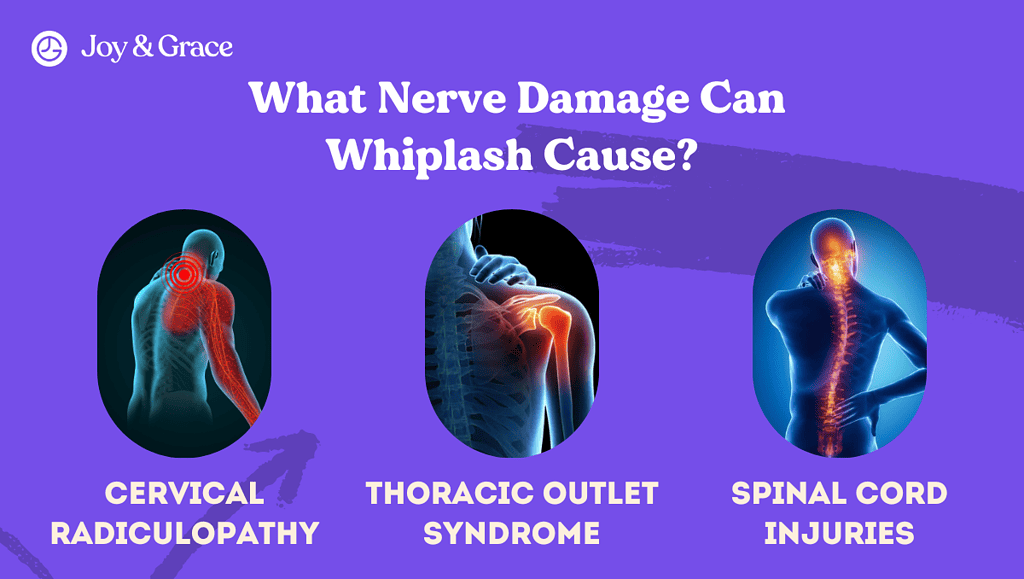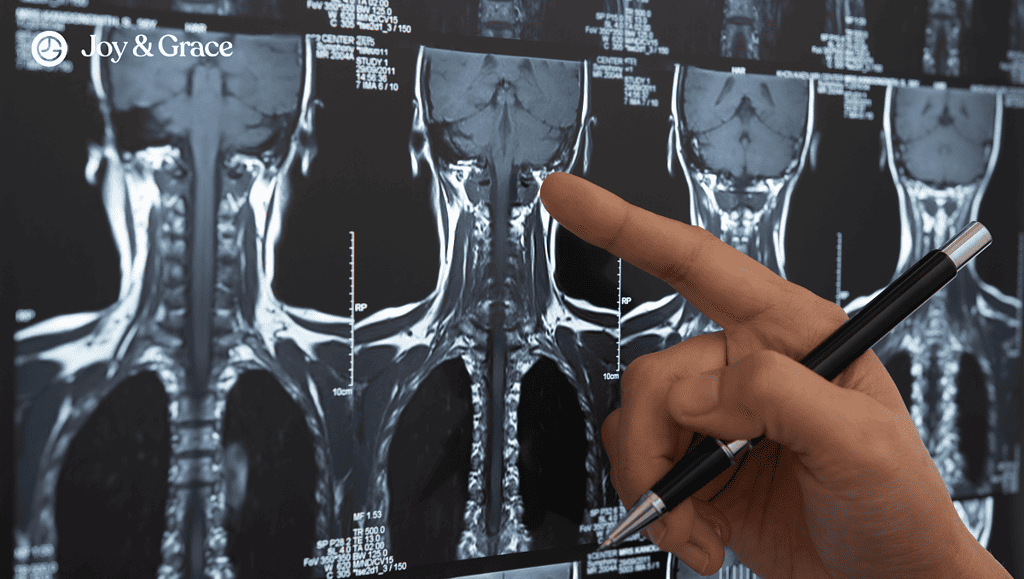Whiplash is a sudden neck movement caused by a forceful forward and backward motion. It often happens in car accidents, sports, or other physical activities. This sudden movement may result in debilitating consequences like neck pain.
So, what causes whiplash neck pain? How do we figure out its cause, and how do we treat it? Let us move forward with the topic smoothly (not forcefully) and answer all of the most frequent questions on the matter.
What Is Whiplash?

Whiplash is a common injury to the neck that happens when the head is jerked back and forth quickly. It often happens in those unexpected car accidents where another car hits yours from behind. A whiplash injury may also occur while playing sports, exercising, or during falls.
What Does Whiplash Neck Pain Feel Like?
Whiplash neck pain is usually dull and spreads across the neck and shoulders. But the pain may also be sharp, shooting, or stabbing. It gets worse when you move or sit in certain ways.
This type of pain is especially troublesome, as it may spread to other body parts, like the arms or upper back.
How Do I Know If I Have Whiplash In My Neck?
If you have recently (or even not-so-recently) been in an auto accident or had a similar incident, you may be experiencing symptoms of whiplash. These symptoms result from the forceful, back-and-forth head jerk characteristic of whiplash.
Let us find out if your complaints fit the common symptoms of a whiplash injury.
What Are The Symptoms Of Neck Whiplash?
A whiplash injury is marked by the following symptoms:
- Pain and stiffness: Two of the most common signs of whiplash. The pain can range from mild to severe, making it difficult to move your head.
- Headaches: Whiplash can also cause headaches, normally starting at the base of the head and spreading to the forehead.
- Pain and muscle spasms in the neck, shoulders, and arms
- Tinnitus: Whiplash may also cause this bizarre ringing in your ears, known as tinnitus.
Seek urgent medical care if your neck pain is accompanied by the following:
- Dizziness or feeling like you are passing out
- Tingling or numbness on both sides of the body
- Weakness in the arms or legs.
- “Electric shocks” along your neck
- Difficulties with walking or sitting upright
- Your neck pain does not get better with painkillers
These whiplash symptoms are alarm signs of potentially dangerous neck nerve damage from the injury.
What Part Of The Neck Hurts With Whiplash?
The top part of your neck is known as the cervical spine. This area consists of seven vertebrae which allow the neck to move in many directions. But this is not all. This area is also where whiplash neck pain is located.
The sudden movement during whiplash may cause the muscles and ligaments that hold the vertebrae together to stretch or tear. The forceful movement may also cause bone, disc, and nerve injury. This will inevitably cause discomfort and severe pain.
Can Whiplash Cause Neck and Shoulder Pain?
As we know by now, whiplash injuries typically affect the neck. But other neighboring structures may suffer as well.
The neck pain from whiplash sometimes radiates to the shoulders, upper back, and arms. This is because of the surrounding muscle and ligament involvement.
According to this particular study, whiplash neck pain is understandably the most common complaint after whiplash. However, 64% of patients in the study felt that their neck pain also spread to their shoulders and/or arms. About 19% of patients complained of headaches, whereas 12% experienced dizziness.
These results prove to us that whiplash can indeed affect other structures aside from the neck.
What Are The Stages Of Neck Whiplash

The Quebec Task Force classifies patients with whiplash based on the severity of signs and symptoms as follows:
- Grade 0: No complaints about the neck. No physical sign(s).
- Grade I: Neck complaint of pain, stiffness, or tenderness only. No physical sign(s).
- Grade II: Neck complaint AND musculoskeletal sign(s). Musculoskeletal signs include decreased range of motion and point tenderness.
- Grade III: Neck complaint AND neurological sign(s). Neurological signs include decreased or absent tendon reflexes, weakness, and sensory deficits.
- Grade IV: Neck complaint AND fracture or dislocation.
What Neck Muscles Are Damaged In Whiplash?
The neck consists of many muscles that rotate and move the neck in all directions. During and after whiplash, the function of neck muscles is often compromised. The neck muscles most vulnerable to whiplash are:
- The levator scapula. The levator scapula raises the shoulder blades to the ears.
- The sternocleidomastoid. This complicated-sounding muscle runs from behind the ear to the collarbone and sternum.
- The trapezius. The trapezius is a large, triangular muscle that covers most of the upper back and neck.
What Nerve Damage Can Whiplash Cause?

The nerves in the neck send signals all over the body. When these nerves are damaged, many symptoms arise. These symptoms are not limited to the neck only. They appear in the limbs and trunk too.
The symptoms that make doctors say, “Agh, nerve problem!” are tingling, burning sensations, numbness, and weakness. It can take a couple of days or even weeks for these to appear.
Some examples of conditions that happen after whiplash are:
- Cervical Radiculopathy, a disease in which a nerve branching off the spinal cord in the neck is pinched, irritated, or inflamed.
- Thoracic Outlet Syndrome, a condition where nerves and blood vessels in the shoulder area are compressed.
- Spinal Cord Injuries, which can cause temporary or lasting paralysis. If you suspect a spinal cord injury from whiplash, seek medical attention immediately.
Can Whiplash Affect My Brain?
When your head is jerked suddenly, the brain can bounce inside the skull. This may lead to a concussion or Traumatic Brain Injury (TBI). TBI can cause damage to brain cells, leading to a range of symptoms.
But studies have also backed up the direct effect of whiplash on the brain, even without a traumatic brain injury present. A study found that people with whiplash have decreased brain activity in specific brain regions. Another comprehensive study states that people with whiplash are more likely to develop depression and anxiety.
These studies also show that about ⅓ of people experience depressive symptoms after 6 to 12 months from the whiplash injury. Moreover, around 15% of people develop PTSD symptoms one year after their whiplash incident.
But why is this all this percentage chatter so important anyway? Well, research results serve as major reasons why we should consider - and not ignore - medical care after experiencing whiplash. Getting the right diagnosis and treatment is essential to maintain a healthy, happy life.
Can Whiplash Affect My Whole Body?

Yes. As we mentioned, the damage you experience from whiplash may indirectly involve your whole body.
Whiplash may lead to depression and anxiety, as we discussed. These conditions can affect all body systems, leading to more suffering.
In rarer cases, the spinal cord might be affected. When the brain and spinal cord experience damage, they do not communicate well with the rest of the body. This may lead to a wide range of symptoms in different body regions.
Diagnosis Of Neck Whiplash
Diagnosing whiplash can be tricky since it is not always visible on imaging. Your doctor will reach a diagnosis based on a physical exam and your medical history.
During the physical exam, the doctor will likely check the following:
- Your range of motion
- Your reflexes
- Your strength
- Signs of tenderness or swelling in the affected area.
Seek medical care as soon as possible if you suspect you have whiplash. Early diagnosis and treatment can help prevent serious, long-term complications.
Can Whiplash Be Seen On An X-Ray?

Whiplash is usually a soft-tissue injury affecting the neck's muscles, tendons, and ligaments rather than the bones. While an X-ray can identify bone injuries, it cannot show damage to the soft tissues. This means it is not always the best method to identify a whiplash injury.
Can An MRI Show Whiplash?
An MRI (Magnetic Resonance Imaging) is a diagnostic scan that uses powerful magnets to create detailed images of the inside of your body.
Even though an MRI can defect soft tissue damage well, it is not always the best imaging test for whiplash. Many doctors will start with X-rays or CT scans to look for bone injuries or abnormalities before moving on to an MRI.
What Is The Best Treatment For Whiplash Neck Pain?

A whiplash injury can limit your neck’s movement and worsen your life quality. But hey, the good news is that you can ease the pain and feel better with the proper treatment!
Here are a few ways to treat whiplash neck pain:
- Immobilization and Ice
- Physical Therapy
- Pain medications
- Surgery
You must rest and immobilize your neck during the first day after your whiplash injury. This helps to reduce discomfort and prevent further strain. It is suggested not to wear any cervical collars or braces, as they have not proven to be useful.
However, prolonged inactivity can worsen muscle stiffness and delay the recovery process. Therefore, it is important to gradually and slowly resume your daily activities.
Ice may also be effective in reducing pain quickly. You can apply ice packs on the neck for 20 minutes several times a day.
Surgery is only recommended in rare cases when there's a severe injury and other treatment options have failed. Surgery options include stabilizing the vertebrae and removing damaged discs or tissues.
To prevent future severe whiplash injuries, your doctor may also recommend you to:
- Use adequate headrests,
- Wear your seatbelt when driving, and
- Use protective gear when playing sports.
What Is The Best Painkiller For Whiplash?
The best pain medicines for whiplash are those that reduce pain and inflammation. Acetaminophen and ibuprofen are popular OTC medications that have proven effective for whiplash neck pain. If your pain is severe, your doctor may prescribe muscle relaxants or narcotics for a short time.
Does Physical Therapy Help Whiplash?
Yes, physical therapy is an effective treatment option for whiplash neck pain. Physical therapists will use various exercises and stretching to:
- Improve neck strength and flexibility
- Reduce pain
- Prevent future injuries.
They may also use heat or ice therapy, electrical stimulation, or ultrasound for healing and pain relief.
What Massage Treatment Is Good For Whiplash?

Massage therapy is an alternative method that can effectively treat whiplash. Massage performed by a licensed professional helps:
- Reduce pain and inflammation
- Improve circulation and range of motion, and
- Promote relaxation and healing.
What Exercises Are Good For Whiplash?
Once you experience the consequences of whiplash, you may not stop thinking about when you can return to your usual active self again.
One of the ways to get rid of neck stiffness is to try out neck exercises at home. Here are some simple and practical exercises to try:
- Neck lengthening exercises:
- Lie on your back with your head flat on a flat pillow or towel. Lengthen the back of your head up the pillow, gently nodding your chin. Feel your neck grow longer. Hold for 5 seconds and repeat 3-5 times.
- Push down through your feet, lengthen your spine, and slowly slide the back of your head up the wall while sitting on a chair. Hold for 5 seconds and repeat 3-5 times.
- Keep your back straight, lengthen the back of your head, and keep looking forward as you gently nod your chin down slightly. Move only as far as there is no obvious increase in tension of the neck muscles. Hold for 5 seconds and repeat 3-5 times.
- Neck rotations: Stand with your feet shoulder-width apart. Slowly turn your head to the left, then to the right. Repeat 10–12 times.
- Head tilts: Tilt your head to the left, bringing your left ear towards your left shoulder. Hold for 5–10 seconds, then repeat on the right side.
- Chin tucks: Sit or stand with good posture and tuck your chin towards your chest. Hold for 5–10 seconds, then release.
- Shoulder rolls: While sitting or standing, roll your shoulders backward, then forward. Repeat 10–12 times.
- Shoulder blade squeezes: Sit or stand with good posture. Then squeeze your shoulder blades together. Hold for 5–10 seconds, then release.
The exercises should be performed 3–4 times a day, and only move as far as pain allows. Do not try to push through pain that you would describe as a 5 on a scale of 1–10.
Remember: You should always consult your doctor before starting exercise for neck whiplash. Start slowly and gradually build up the number of repetitions. Make sure to stop any movement that causes pain or discomfort.
Is Heat Good For Whiplash?
Applying a warm compress or heating pad to the affected area increases blood flow and relaxes the muscles. This may help reduce pain and stiffness caused by whiplash. However, the effectiveness of heat therapy for whiplash neck pain is still up for debate among medical professionals.
Heat therapy should not be used in the acute stage of whiplash. This is because it may add to inflammation and pain. Instead, ice therapy is typically recommended in the first 24-48 hours after a whiplash injury.
How Long Does Neck Pain Last After Whiplash?
Whiplash neck pain usually gets better on its own within 2 to 3 weeks. But in some people, the effects of whiplash may be long-lasting. Neck pain may sometimes last for years after the initial injury.
One of the main reasons whiplash causes neck pain years later is poor healing. Without proper healing, the neck can become weak and vulnerable to further damage.
Another factor that can contribute to chronic whiplash neck pain is the type of treatment the person receives. Without proper medical treatment, the neck may not fully heal for years. This is why following your doctor’s advice and treatment plan is essential.
Is Whiplash A Permanent Injury?

The good news is that, in most cases, whiplash is not a permanent injury. Whiplash neck pain usually resolves on its own within a few weeks with proper rest and self-care.
In other, less frequent cases, it can lead to chronic pain and other long-term complications.
Factors that can contribute to the severity and duration of whiplash include:
- The force of the impact: The greater the force, the more severe the whiplash can be.
- Age: People who are older or who already have health problems may be more likely to have long-term problems.
- Previous injuries: You may be more likely to develop chronic pain if you have experienced whiplash before.
- Treatment: Early treatment and proper self-care can improve your chances of recovering fully.
Whiplash is not always a permanent injury. But we recommend you seek professional medical advice the moment you experience symptoms.
How Long Does It Take To Recover From Whiplash Fully?
If you have suffered a neck whiplash injury, you may want to know that whiplash can indeed heal fully!
The outlook for whiplash injuries is generally good. Over the past few decades, recovery rates have remained unchanged. About one-half of individuals who experienced whiplash will fully recover. The remaining half will continue to experience some level of non-recovery. Recovery usually happens within the first 3 months of the injury, with little improvement after this period.
At Joy & Grace, we emphasize practicing self-care. Stay hydrated, rest adequately, and follow your doctor’s recommendations for the quickest recovery possible.
What Can Make Whiplash Worse?
A whiplash neck injury requires close attention. If left untreated, whiplash may lead to serious complications. Let us discover these complications and what you should avoid when dealing with whiplash.
What Not To Do After Whiplash?
If you have experienced whiplash, you must take care of yourself to prevent further damage and ease your symptoms. Here are a few things that you should pay attention to after experiencing whiplash:
- Maintain a comfortable upright sitting position, or lie down in a comfortable position for short periods (20–30 minutes).
- Avoid sudden and/or extensive neck movements.
- Avoid prolonged postures, e.g., working at a desk; change posture regularly.
- Do not delay medical attention. Listen to your doctor’s advice.
- Do not skip physical therapy.
- Do not ignore pain and self-care.
- Do not resume normal activities too soon.
- Start driving your car again only after you feel safe controlling it.
- Avoid smoking, as it can delay healing time.
What Happens If Whiplash Is Left Untreated?

Untreated whiplash is a big red flag because it can cause a range of serious complications, such as:
- Chronic neck pain: When the pain persists for more than three months, it is considered chronic.
- Depression: Chronic pain can lead to depression, anxiety, and other mental health issues. This can further impact your recovery process.
- Reduced Range of Movement: Untreated whiplash neck pain can cause severe joint stiffness. This can make it difficult for you to perform your usual activities.
- Arthritis: Whiplash can damage the joints and bones in the neck, leading to arthritis later in life.
- Insomnia: Painful and stiff muscles can lead to disrupted sleep, further complicating healing.
- Symptoms that mimic Dementia: Untreated whiplash can cause memory problems and difficulty concentrating.
Treating whiplash early is essential to prevent these long-term consequences.
What Is Late Whiplash Syndrome?
One of the most concerning potential consequences of whiplash is a condition known as "Late Whiplash Syndrome." This term refers to a set of symptoms that can occur weeks, months, or even years after the initial injury. According to a 2008 study, 14% to 42% of patients are left with chronic symptoms following a whiplash neck injury.
Late whiplash syndrome may be associated with the following symptoms:
- Chronic neck pain and stiffness
- Headaches
- Dizziness or vertigo
- Numbness or tingling in the arms or hands
- Difficulty concentrating or remembering things
- Fatigue
- Irritability or anxiety
- Tinnitus (ringing in the ears)
- Sleep disturbances
- Sensitivity to light or noise
Takeaway
Whiplash is a common injury that occurs in the neck after a forceful movement of the head. In whiplash, the head moves backward and forwards suddenly and quickly. Whiplash often happens in motor vehicle accidents, especially rear-end collisions.
Whiplash neck pain is usually dull and spreads across the neck and shoulders.
The most characteristic symptoms of whiplash include the following:
- Pain and stiffness
- Headaches
- Dizziness
- Tingling or numbness
- Tinnitus
Whiplash is not always visible on imaging. Your doctor will reach a diagnosis based on a physical exam and your medical history.
The treatment of whiplash injuries involves:
- Rest, Immobilization, and Ice
- Physical Therapy
- Medications
- Surgery
Sometimes, neck whiplash can resolve within a few weeks with proper rest and self-care. In other cases, it can lead to chronic pain and other long-term complications.
To prevent future severe whiplash injuries, your doctor may also recommend you to:
- Use adequate headrests,
- Wear your seatbelt when driving, and
- Use protective gear when playing sports.















